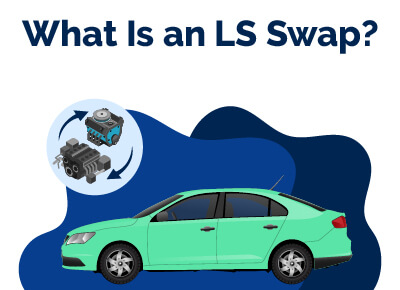What Is an LS Swap Engine?
August 10, 2023


Chris is Head of Content for FindTheBestCarPrice and is based out of Philadelphia, PA. As a seasoned automotive industry analyst and car enthusiast, he ensures the highest level of quality across all our content and curates our picks for the best deals each month.
Chris studied information systems and marketing at Drexel University and writes about a wide range of topics ranging from car buying tips to troubleshooting common mechanical issues.
When he’s not thinking about cars, he likes to stay in with his dog and make an “attempt” to finish a crossword puzzle (he’s not quite at the Saturday/Sunday level…yet). As a former cheesemonger, Chris still has a “sharp” passion for all things cheese, and his fridge is always loaded with it!
Chris also has a passion for things that go fast, and drones are no exception. He spends some of his time writing for Dronesourced.
Engine swaps involve the replacement of an existing engine with a new one. It is either done to replace a failed engine with the same model or to upgrade the original engine.
One popular type of engine swap is the LS engine swap, which utilizes General Motors' LS V8 engine series in various form factors.
The LS engine swap offers ample customization opportunities and is commonly chosen by those seeking to add power to their vehicles.
If you're curious about what an LS engine swap is, here's what you need to know. An LS swap refers to using any form factor of General Motors' LS V8 engine series in an engine swap.
According to Motor Trend's 2020 observation, the Chevy LS V-8 engine has become the go-to suggestion for engine swaps among those looking to enhance the power of their vehicles, owing to its compact size and lightweight.
Table of Contents
Things You Need for an LS Swap
While the options for an LS engine swap are vast, let's go over some fundamental components to consider when embarking on the project:
1. Steam Tubes
The steam tubes atop the engine heads are a heat prevention mechanism to safeguard against overheating.
When installing these tubes, ensure they are connected to a location where the air can safely escape, such as the water pump spacers, water pump housing, or radiator.
It is crucial to leave them uncapped unless all the air in the coolant system has been thoroughly bled off.
2. Motor Mounts
To connect these motors, an adapter plate may be required. These plates are fastened to the LS engine block, providing a secure attachment to the cross member.
Adjustable and stock location plates are available depending on your requirements, which connect to the interface between the engine and transmission.
Remember that most cars may need the LS engine to be moved forward to accommodate firewall clearance, so it's essential to measure and plan for these adjustments carefully.
3. Exhaust Systems
There are abundant exhaust system options available, but all of them will necessitate adjusting the factory pipe length to fit the specific exhaust system of the car.
Opting for headers instead of factory LS manifolds can increase top-end horsepower and enhance the engine's performance.
Retaining the manifolds will provide ample low-end torque and a quieter driving experience.
4. Transmissions
There are various transmission options when performing an LS engine swap. The GM TH350, TH400, and 700R automatic transmissions are popular choices for those on a budget, but they will require a flexplate adapter.
The GM 4L60E is often recommended due to its favorable performance-to-price ratio.
The T56 and TR6060 are highly recommended for manual transmissions as they can easily bolt to any LS engine.
However, other manual transmissions may require additional adaptations to ensure safe functionality.
5. Carb Conversions
If you opt for a carbureted setup in your engine swap, you must use a carburetor LS intake manifold, which offers numerous options.
Switching to a carburetor can simplify the setup by eliminating the need for knock sensors and associated wiring.
However, it's important to note that a carbureted setup lacks a distributor, so you will require a control box to manage the ignition system.
6. Wiring and Computer Systems
LS engine swaps offer three options for engine wiring harnesses: a standalone harness, a custom harness, or a rewiring of the original harness that came with the engine.
Rewiring the original harness is the most common option due to its cost-effectiveness and ease of completion by a professional.
Although the wiring process may appear straightforward, seeking professional assistance during this step of your engine swap is highly recommended to ensure optimal results.
7. Fuel Systems
In LS engine swaps, the most prevalent method for fuel systems is to utilize a C5 Corvette fuel pressure regulator in combination with an electric fuel pump that matches the required flow rate.
If your vehicle lacks a fuel injection-rated fuel line, install one to ensure consistent fuel pressure.
Although not mandatory, using an intake pump with proper baffling is recommended to prevent fuel starvation during low fuel tank levels.
8. Gauges
Selecting appropriate gauges is crucial for gaining insights into your vehicle's performance.
Mechanical gauges can be attached to the LS engine block using adapter fittings and may include options such as a factory speedometer or mechanical speedometer, depending on your transmission type.
Alternatively, electronic gauges can be conveniently wired to the LS wiring harness for seamless integration.
Carefully choose gauges that suit your needs to monitor your car's internal operations accurately.
Advantages of LS Swap Engine
LS engines offer a cost-effective solution that combines versatility for various applications with impressive power capabilities. The following are pros of the LS Engine Swap:
1. High Value
If you're mindful of your budget, an LS conversion can deliver impressive horsepower without breaking the bank or causing conflicts with your significant other.
On the other hand, if you've saved up for years to build your dream car and have more to spare, achieving a thousand horsepower or more is easily achievable with an LS engine, leaving room for other upgrades like a paint job or interior enhancements.
General Motors has consistently produced purpose-built performance machines that have dominated the motorsports scene.
With their cost-effectiveness, power output, and reliability, LS engines remain valuable, making them highly sought-after by car builders.
Even if you start with a smaller LS engine with less power, a few simple modifications can quickly wake up the engine and generate more horsepower at the wheels.
For instance, adding a high-performance camshaft can unleash as much as 100 horsepower without breaking the bank or requiring complex installations.
Moreover, LS engines are readily available in junkyards, driveways, and garages across the country, making them easily accessible to builders.
2. Several Options
Many choices are available regarding engine displacement, presenting you with the delightful predicament of determining the optimal size for your powerplant.
This is not necessarily a harmful problem to face, and it is one of the reasons why LS engine swaps have become so pervasive.
Once you have established the direction for your project, you will be presented with an array of engines to choose from, ranging in size from substantial to diminutive.
These options cater to intrepid car builders who relish the opportunity to deviate from the norm.
For instance, shoehorning an LS7 engine into a smaller car may pose some challenges in terms of spatial constraints.
However, if you are determined to carry out an LS swap, fret not, as you will have a range of choices to make your vision a reality; with the proper exhaust setup to keep the decibels in check, you will undoubtedly leave many in awe on the track, creating the epitome of a sleeper vehicle.
3. Exceptional Performance
The performance of an engine is paramount, regardless of any other considerations. Whether a factory-spec 5.3L or a force-fed supercharged 427, LS engines are renowned for their ability to excel.
General Motors demonstrated astute engineering prowess in designing these V8 powerplants, leveraging cutting-edge technology to achieve peak performance.
One unique approach was their meticulous attention to optimizing the head design, a key element in their pursuit of the perfect engine.
In addition, they took meticulous care in crafting their intake manifolds, tailoring them for specific applications.
Their truck manifolds were engineered to deliver exceptional low-end torque, while their car-style counterparts were designed to unleash power at higher RPMs.
Furthermore, LS engines exhibit impressive responsiveness to common modifications; even basic upgrades such as intake and exhaust modifications yield substantial horsepower gains.
LS engines' magnetic appeal is undeniable, which is why we have consistently chosen them for many of our projects.
This time-honored tradition shows no signs of waning, as LS engines are expected to remain a steadfast choice for discerning car builders in the foreseeable future.
4. Their Different Weights and Measurements
An exemplary demonstration of General Motors' ingenuity in engineering can be observed in fitting a 5.7L LS1 engine into smaller cars without a significant increase in weight.
While a 2.0L inline-four Civic motor weighs around 300 pounds, the LS1 engine with four additional cylinders and 3.7 more liters only adds 160 pounds with all its accessories attached - an impressive feat.
What sets the LS engine apart in this regard? How do they achieve such compactness compared to their competitors?
For starters, General Motors continues employing the push-rod design, considered "old school" in modern engine building.
According to some, Chevrolet Corvette stands as the last sports car that still utilizes a push-rod V8, which is far better than commonly perceived.
Push-rod engines are not excessively heavy; they are simple in design, have fewer moving parts prone to wear and tear over time, and are considerably more cost-effective to manufacture.
These reasons collectively contribute to the Corvette's reputation as an affordable high-performance sports car, further establishing the LS engine's superiority.
Best Car Deals by Category
Frequently Asked Questions
What are the benefits of an LS swap engine?
The benefits of an LS swap engine include increased performance, wider availability of parts, reliability, and weight savings.
What are the challenges of an LS swap engine?
While LS swap engines offer many benefits, some challenges may arise and include time-consuming modifications, additional costs tied to those modifications, legal and emissions considerations, and the engine not being compatible with all vehicles.
Posted in Car Buying Tips, Car Troubleshooting |




